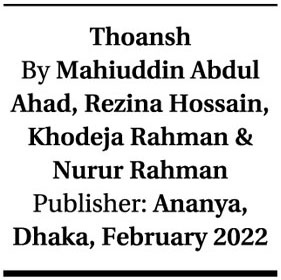 According to reliable estimates, there are currently over seven thousand active languages in the world. However, human languages also have hundreds of branches and sub-branches based on regional or territorial variations, which are usually called dialects. Bangla also has numerous regional variants, and one such variety is called 'Noakhailla', which is spoken widely in the Noakhali region - now comprising the districts of Noakhali, Lakshmipur, and Feni. Although not much attention is paid now-a-days to the study and research of regional dialects in Bangladesh, a recent attempt by four expatriate Bangladeshis living in Australia to present their lifelong knowledge and experience with the 'Noakhailla' dialect in a book titled 'Thoansh' is certainly encouraging and praiseworthy.
According to reliable estimates, there are currently over seven thousand active languages in the world. However, human languages also have hundreds of branches and sub-branches based on regional or territorial variations, which are usually called dialects. Bangla also has numerous regional variants, and one such variety is called 'Noakhailla', which is spoken widely in the Noakhali region - now comprising the districts of Noakhali, Lakshmipur, and Feni. Although not much attention is paid now-a-days to the study and research of regional dialects in Bangladesh, a recent attempt by four expatriate Bangladeshis living in Australia to present their lifelong knowledge and experience with the 'Noakhailla' dialect in a book titled 'Thoansh' is certainly encouraging and praiseworthy.
Hailing from the Noakhali region, the four initiators of the book now live in Melbourne, Australia. Despite their varying professional backgrounds, they came together to undertake a collective journey down memory lane during the difficult days of Covid-19 pandemic in 2020 and 2021. This has resulted in the publication of the book that was formally released recently during the Ekushey Book Fair-2022. The writers-cum-compilers of the book are well-known physician-cum-community leader Dr. M A Ahad (Babar), ex-civil servant Rezina Hossain (Chhobi), housewife Khodeja Rahman (Nargis), and former ship-captain Nurur Rahman (Asheq).
As is well-known, Bangla is a 'Prakrita' language that is a sub-variety of the Indo-Iranian language class, which in turn emerged from the 'Satem' branch of the Indo-European languages, the other branch being 'Kmtom'. According to the book 'Origin and Development of Bengali Language' (1975) by Suniti Kumar Chatterjee, the Bangla dialects are basically of four types, viz. Rarhi, Varendri, Kamrup and Vanga, and the 'Noakhailla' dialect belongs to the south-eastern sub-category of Vanga. On the other hand, Dr. Muhammad Shahidullah placed this dialect under the 'Prachya' branch, as opposed to the 'Pashchatya' branch of Bangla dialects. By refining this classification, Paresh Chandra Mazumdar (1992) placed Noakhailla dialect under the 'Purbodeshi' sub-category of Prachya (Vangio) branch, the other branch being Pashchatya (Gourhi).
Printed with an attractive cover depicting the vegetable called 'Thoansh' in local dialect, this slim book of 62 pages contains an executive summary and introduction in English, as well as a preface, an introduction, and seven chapters in Bangla-cum-Noakhailla dialect. The first chapter tells some familiar and unfamiliar stories; the second recalls some Noakhailla verses, jokes and proverbs; the third tells stories of day-to-day life; the fourth touches on spelling distortions in Noakhailla dialect; the fifth dwells on cooking, vegetables, and names of birds and animals; the sixth on names of people and places; and the seventh chapter narrates some tales and incidents. Besides, there are segments on Noakhailla songs and poems, the contributions of Noakhaillas, as well as a glossary of common words. As the authors put it in their dedication page, the vegetable 'Thoansh' was found in a few places of Noakhali region, but is now on the verge of extinction. Similarly, the Noakhailla dialect also appears to be on a path of gradual decline in terms of usage, which has motivated them to undertake this venture.
Despite some proofreading errors here and there, the book is undoubtedly a commendable initiative that is likely to serve as a trend-setter for undertaking more such works on the rich and diverse regional dialects of Bangladesh. As the valiant freedom fighter and former secretary Waliul Islam points out in the preface, the Noakhailla dialect is often used by expatriates to add spice and colour to their gossiping sessions. Overall, the book is undoubtedly a time-befitting one, and deserves wide publicity at home and abroad.
Dr Helal Uddin Ahmed is a retired Additional Secretary and former Editor of Bangladesh Quarterly. hahmed1960@gmail.com